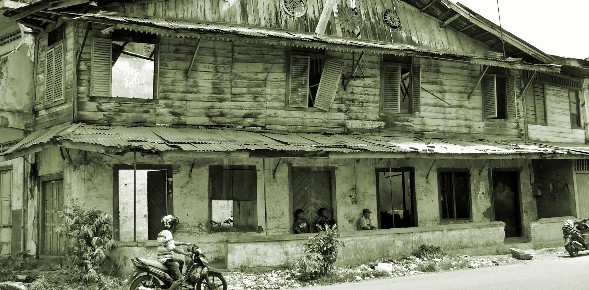Half-way of the year 2012 and Padang is still full of structures in ruins. In the city centre, the previous Central Market with its collapsed roof and is closed to the public.
Two years and a half following a devastating earthquake in West Sumatra, the provincial capital city of Padang continues to bear the scars of a massive earthquake, which shook up the region. It was on September 30, 2009 that the earthquake with a magnitude of 7.9 on the Richter scale struck Padang and its surrounding with devastating consequences. The earthquake killed over 1,100 deads and affected 250,000 families in the region. In addition, it made irreversible damages to the area, destroying severely around 135,000 houses and damaging another 145,000 houses.
Half-way of the year 2012 and Padang is still full of structures in ruins. In the city centre, the previous Central Market with its collapsed roof and is closed to the public. Shops have since settled around the Market’s massive empty frame while waiting for a new market to be achieved. Nearby, 1930s- Dutch style city hall is still wait for funds to repair its damaged facades. At night, there is an eerie feeling in the quiet city centre. Only young people continue to watch spectacular sunset and have dinner along Padang Beach in the city centre.
While major structures such as schools and hospitals have been rebuilt, many houses are merely rubble. Padang’s earthquake most tragic vision is in the Old Town (Kota Lama), an invaluable heritage area with its mix of Dutch colonial and Chinese homes including some 20 old temples. More than 70 heritage buildings belonging to the state, private companies and individuals were heavily damaged by the 7.9-magnitude earthquake that hit the city on Sept. 30, 2009.
Things got even worse for most old buildings, as many people scavenged materials from the damaged historical sites, and some of the buildings’ owners knocked down parts of their structures that they felt had become dangerous. An Indonesian institution, the Batusangkar Prehistoric Legacy Conservation Center (BP3) is regularly reporting of further destructions.
Despite the presence of a program initiated with the UNESCO and Japan, nothing has moved in the last two years. “They are no priorities, no money and most of the houses owners are not living anymore in Padang. They showed little interest for the reconstruction of the city,” says Dr Eko Alvares, Rector of Bung Hatta University in Padang and looking at urban planning. In 2010, reconstruction was estimated to cost some US$ 650 million for the old town. But as time passes by, costs are getting higher as structures continue to collapse. A masterplan has recently been submitted with 77 buildings being earmarked as of historical values. It does not mean that they will still be preserved. Padang Kota Lama (Old Town) might just disappear, forgotten and ignored from local authorities and private entrepreneurs.
Of course, priority was first given to schools, hospitals, public facilities and then religious buildings to be reconstructed. Among the 77 earnmarked heritage buildings out, only six have been restored with financial aid from third parties in 2010, including the Gantiang Mosque, state junior high school SMPN 1 Padang and a church. Another six heritage buildings were also proposed in 2011 State Budget at a cost of INR 4 billion (US$ 45 million). But no further buildings restoration has been so far submitted. And so far, nothing has been done on six new building earmarked for restoration (city Hall, Buddhist temple, Geo Wehry, a Cement Distributor building, the BTN building and the Pulau Air station). Most are located along the banks of Batang Arau River, Padang.
Christians in Padang have been for example very active to rebuild all the destroyed institutions. Churches as well as a monastery have since been restored. The St Leo Church monastery was supported by the Prins Claus Fund for culture from Holland. The foundation was also involved into the renovation of the Lubuak Bareh Mosque.
Most sadly, it seems that Padang is also almost forgotten from travellers. “We received almost 2.3 million, tourists in 2011. It seems a lot but the number of foreigners is still modest, representing only 47,000 arrivals last year. And they are mostly in transfer and might only spend a night on their way to Mentawai Island or diving spots”, explains Trisna Putra, Head of Planning at Padang tourism bureau. It is maybe time to both Indonesia and regional West Sumatra governments to make again tourism a priority to revive Padang city.
Luc Citrinot a French national is a freelance journalist and consultant in tourism and air transport with over 20 years experience. Based in Paris and Bangkok, he works for various travel and air transport trade publications in Europe and Asia.




![[PR] PR_Ascott and Vimut Hospital_2024](https://www.traveldailynews.asia/wp-content/uploads/2024/04/PR-PR_Ascott-and-Vimut-Hospital_2024-400x265.jpg)




























































